On a Saturday there is an early bus from Aberaeron to Aberporth, but it is not Saturday. On a Thursday the earliest bus arrives at Aberporth at 11:16, and the last bus from Cardigan, 12 miles away, is at half past six – doable, but rather tight. So, with the help of the tourist board the day before, who were so helpful, I took an earlier bus to Gogerddan Arms and walked two miles down the road to Aberporth.
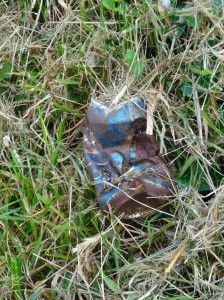
I notice on the bus that while the timetable spells it the Welsh way, the ticket machine and ticket say it in English ‘Gogerthan‘.
Walking two miles along a road with no turnings and just three photos (it was not Coast Path, but I couldn’t help it), I averaged four miles an hour, rather than the two miles an hour I seem to make on the path itself.
Next door to the Ship Inn, where they had been so welcoming two days before, is ‘Caffi Sgadan‘, fish and chip take away and café. They serve breakfast. Roll forward an hour and I finish, to be fair quite a bit of reading and writing amongst the bacon and fried bread.
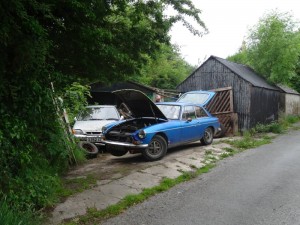 Sated, I pass a lovely community history mosaic and a carved dolphin overlooking the sea, before taking the steep lane up to Parcllyn, the top part of which seems to be public housing for the military base. Partway up I stop to photograph an old sports car, I think maybe an MG, with its bonnet a different colour to the rest of the car, when its owner emerges from the shed, a rusty engine part in his hands.
Sated, I pass a lovely community history mosaic and a carved dolphin overlooking the sea, before taking the steep lane up to Parcllyn, the top part of which seems to be public housing for the military base. Partway up I stop to photograph an old sports car, I think maybe an MG, with its bonnet a different colour to the rest of the car, when its owner emerges from the shed, a rusty engine part in his hands.
"Lovely car," I say, "looks well used".
"No good having a posh car just for show," he replied, "if you have a fun car you might as well use it."
Probably not a bad philosophy of life.
The path takes an inland route through Parcllyn because of the MOD base on the headland. They must do live firing from here, as a danger area extends out to sea in a wide arc with the base at its apex. At the entrance to the base is a QinetiQ sign and a missile (I assume not live!), just like the missile in the community mosaic on the seafront. Notices on the fence say:
Images of Trespassers
May be Recorded
Which, to be honest, is far less daunting than some of the bulls along the path.
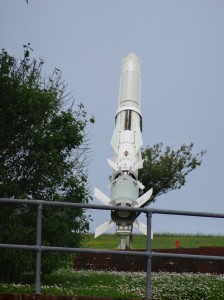 The path skirts the base and as I go around I take photographs, both of the radar tower on the base and also the houses opposite, the missile at the entrance and a disused public toilet that is up for sale as a building plot. I wonder what the CCTV cameras make of this long-haired itinerant alternately marching at high speed along the road and then taking photos of the base.
The path skirts the base and as I go around I take photographs, both of the radar tower on the base and also the houses opposite, the missile at the entrance and a disused public toilet that is up for sale as a building plot. I wonder what the CCTV cameras make of this long-haired itinerant alternately marching at high speed along the road and then taking photos of the base.
A short while after I go through one field gate I hear the metallic clank of another person heading into the field behind me. So unused to seeing people on the path, I do for a moment imagine that perhaps this is the plain clothes officer ready to take me in for questioning!
I am in the middle of reading two books at present: one is ‘The Lost Art of Walking‘, a combination of literature, history and general philosophising about walking, the other is ‘To Dream of Freedom‘, a history of the Free Wales Army and other armed Welsh nationalist groups in the 1960s. I’m quite glad it is the former I have in my rucksack today.
In fact, the path this day is busier than I have ever seen it, which is not saying a lot, but in the stretch south of Aberporth I pass three other people going in my direction and several going the opposite way. As I stop to take photos, the man overtakes me, and certainly does not look the military type, and later we walk together for a short while.
He turns out to be a local from Aberporth, but a frequent walker. Living on the coast, he said he more frequently walks inland now, but had clearly been walking the coast in recent days. One of the ladies I’d passed by this stage was on a walking holiday and said she had seen many dolphins on this trip, both around Aberystwyth and near New Quay, indeed dolphins weere the reason we had first visited New Quay many years ago.
However, the local man said of his recent walking in the area, "forty miles along the coast and I don’t see any dolphins, but looking out of my living room window …"
We wonder whether this is just the fact that when clifftop walking you have to keep at least half an eye on the path to avoid joining the dolphins.
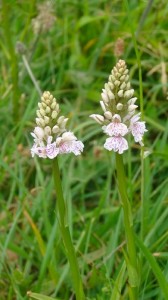 He tells me a bit about the area: first that this had been a major area for Free Wales Army support, although he had never seen the curious flag of the red Welsh dragon on black background that I’d seen a few times on Llŷn.
He tells me a bit about the area: first that this had been a major area for Free Wales Army support, although he had never seen the curious flag of the red Welsh dragon on black background that I’d seen a few times on Llŷn.
I remark that Aberporth still seems to be a village as well as a seaside town and how I love the railway carriages. He tells me that a little inland where a disused railway line runs, there is an even bigger concentration of railway carriage homes. He also tells me about the general nature of the town.
"It’s an unusual sort of seaside place, mostly repeat tourists who find it and then keep coming, but it is not well known. They don’t advertise it because of the base."
Clearly the presence of a military base is not a hindrance to advertising other seaside resorts, I think of Rhosneigr overlooking Valley airfield, where Prince William operates from. Maybe this is just a complaint by local businesses about tourist board priorities that are really driven by other reasons, or maybe the fact that this is an R&D facility really does impact on tourist policy.
Then we spot some dolphins out to sea and while he stops to watch them play, I continue along the path.
I walk briskly past the small, unmanned radar installation beside the path that says ‘Danger Non Ionising Radiation’ (although not enough to warm the water bottles) and after a while find myself looking down on Mwnt.
 Mwnt is named after the conical rocky hill (mount/mwnt) that rises 250 feet from an otherwise low and flat river valley that cuts a wide swathe through the low cliffs north and south. In the lee of the hill is a small white church dedicated to the Cross, ‘Eglwys y Gros‘. Evidently the rare dedication to the Cross suggests that its origins are even older then the building there today, dating back to the seventh or even fifth century. Certainly it was a major stopping point on pilgrim routes.
Mwnt is named after the conical rocky hill (mount/mwnt) that rises 250 feet from an otherwise low and flat river valley that cuts a wide swathe through the low cliffs north and south. In the lee of the hill is a small white church dedicated to the Cross, ‘Eglwys y Gros‘. Evidently the rare dedication to the Cross suggests that its origins are even older then the building there today, dating back to the seventh or even fifth century. Certainly it was a major stopping point on pilgrim routes.
On the top of the hill itself, Steve and Cindy sit watching the sea. They have an itinerant life, "we’ve been everywhere," they say, and their son is still in Australia where they lived for some time on a huge sandbar near Melbourne. They do not like cities, and after Australia find Britain so crowded. However, they did not like the rampant materialism of Australian culture and grieved at the impact this had on the natural world.
They also had been shocked at the general level of racism there, both towards general immigrants, but in particular to the aborigines. I recall, albeit a few years ago, my shock when, in the run-up to the Commonwealth Games, the Governor of the State the games were to be held in said that it was no good any of the jobs or money from the Games going to the aborigines, "they would just drink it away," he said.
"They do encourage them to drink," said Cindy, talking of the big corporations, "and then take their lands, as they have lots of minerals in. They (the aborigines) know so much about the land, but are treated so badly."
I recalled the film ‘Bury my Heart at Wounded Knee‘, and the parallels there, the original Sioux reservation cut up to enable access to the gold in the mountains.
Steve and Cindy are Jehovah’s Witnesses, and immediately after this break were heading up to Livingston where a new Kingdom Hall is being built. Steve is an electrician and gives his services for free in return only for board and lodging. He remarks on the way they are often welcomed into people’s homes, people who they have never met before, and I recall some of the hospitality on this journey, not least the way Paul and his family welcomed me in Caernarfon.
 Carrying a takeaway tea from the small shop and kiosk at Mwnt, I continue along the cliff at, but soon turn inland. The original Ceredigion Coast Path along the cliff has been closed because, according to a notice, it is ‘illegally close to the cliff edge’. However, I am later told that this is more due to a landowner who doesn’t really want the path and uses safety as an excuse. However, cliff paths can be dangerous, or as the frequent notices say ‘Cliffs can Kill’, as only recently a woman fell to her death near Mwnt. I didn’t notice any particularly dangerous parts on the main path, but the rocks around are sloping and many smaller paths cut close to the edge. Over much of this coast there is a layer of soft, probably glacial moraine material, overlaying the harder rock below. The layer of soil and soft rock can easily break, and the edges, which may look secure, can easily shear off, like the snowy overhanging edges that form on mountain arêtes.
Carrying a takeaway tea from the small shop and kiosk at Mwnt, I continue along the cliff at, but soon turn inland. The original Ceredigion Coast Path along the cliff has been closed because, according to a notice, it is ‘illegally close to the cliff edge’. However, I am later told that this is more due to a landowner who doesn’t really want the path and uses safety as an excuse. However, cliff paths can be dangerous, or as the frequent notices say ‘Cliffs can Kill’, as only recently a woman fell to her death near Mwnt. I didn’t notice any particularly dangerous parts on the main path, but the rocks around are sloping and many smaller paths cut close to the edge. Over much of this coast there is a layer of soft, probably glacial moraine material, overlaying the harder rock below. The layer of soil and soft rock can easily break, and the edges, which may look secure, can easily shear off, like the snowy overhanging edges that form on mountain arêtes.
The ‘away from the coast’ section follows a combination of fields and farm tracks, and eventually joins the small road leading down into Gwbert. A lady, Sheila, asks if I am on the Coast Path and tells me about an alternative route through the golf course instead of following the road through Gwbert. This is all on public footpaths and bridleways, and is slightly further from the sea and estuary, but has views right the way across to Poppit Sands. She said the path had recently been moved to avoid badger setts, although she notes several badger holes as we go along the current path. Maybe this is why they haven’t used this path; Sheila is connected to the golf club and didn’t know of any objections from there.
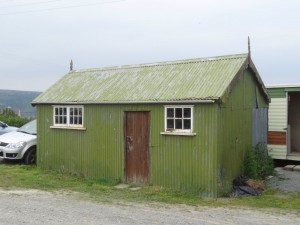 The last section between Gwbert and Cardigan is back to fields and farm tracks, passing fields of leeks, some under thin plastic covers and already big enough to eat, others planted in the open ground and much smaller. I recall just a few days ago, on a more exposed piece of coast, seeing a field of leeks under plastic, but it was far less developed, maybe just the more exposed location, or maybe to do with planting time. When I say plastic, I mean the kind that rises with the crop and then decays in the sun. I recall, when I worked at the agricultural engineering institute at Silsoe, that this use of plastics was just beginning, I think at that stage more with opaque black plastics to act as a weed suppressing mulch and to warm the ground for crops like potatoes. For the leeks, you could see on the less developed field that the leek seeds or plantlets had been directly sown through the plastic, above each leek a small slit, some with the leek already pushing through.
The last section between Gwbert and Cardigan is back to fields and farm tracks, passing fields of leeks, some under thin plastic covers and already big enough to eat, others planted in the open ground and much smaller. I recall just a few days ago, on a more exposed piece of coast, seeing a field of leeks under plastic, but it was far less developed, maybe just the more exposed location, or maybe to do with planting time. When I say plastic, I mean the kind that rises with the crop and then decays in the sun. I recall, when I worked at the agricultural engineering institute at Silsoe, that this use of plastics was just beginning, I think at that stage more with opaque black plastics to act as a weed suppressing mulch and to warm the ground for crops like potatoes. For the leeks, you could see on the less developed field that the leek seeds or plantlets had been directly sown through the plastic, above each leek a small slit, some with the leek already pushing through.
The path reaches the river edge near Old Castle Farm. Was there an ‘old castle’ here before the current castle was built in Pembroke itself? It then follows along the lightly wooded river bank until you pass a fence separating you from something vaguely industrial/chemical. I realise it is the sewerage works, although unusually not from the smell. Each part carries a label, sometimes enigmatic. The ‘sludge batching plant’ is fairly obvious, but what about the ‘cake pump room’? I imagine Willy Wonka pulling a lever and cupcakes pouring out of a bright pink pipe.
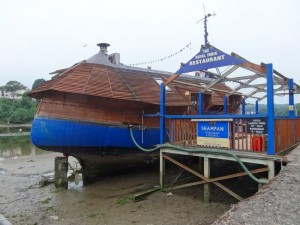 It seems Johnny Depp inhabits this landscape: just a short way further I expect him to appear, charming and just a little dangerous looking, as a junk-like river-boat appears. I feel I have been transported into ‘Chocolat‘. It is an Indian restaurant; what an evening out.
It seems Johnny Depp inhabits this landscape: just a short way further I expect him to appear, charming and just a little dangerous looking, as a junk-like river-boat appears. I feel I have been transported into ‘Chocolat‘. It is an Indian restaurant; what an evening out.
